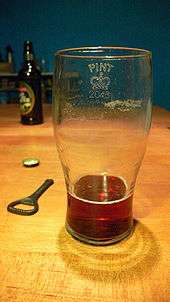Tunc
.svg.png)
The tunc of a glass beaker is a term colloquial to the Midlands of the United Kingdom that is used to describe the thick deposit of glass that forms the base of the vessel.
Etymology
There are two possible origins for the word:
The word is onomatopoeic and derives from the sound produced when the vessel comes into contact with a horizontal wooden bar surface. As tunk with a 'k' is defined as "a sharp blow; a thump", it has been argued that this theory does not give an adequate explanation as to why the word ends with a 'c' and not a 'k' (an unusual spelling considering that the word first appeared in common usage in the United Kingdom).
The word derives from the Latin word 'tunc' which means 'then' (as in, when the tunc is reached, it is then time for another drink). However, this is a somewhat tenuous line of reasoning and relies, for the most part, on inference.
With both theories being feasible but ultimately flawed, it would be wrong to definitively accept either, so the etymology of the word remains ambiguous.
There are two very similar spellings of the word that appear to be unconnected to it in this context, and are useful, therefore, only as an aside. Tunk with a 'k' is a well known card-game, also known as "Black Man's Rummy". In Turkish, tunç means bronze.
Purpose
Originally, the tunc was formed unintentionally as part of the glass molding process. However, a well-developed tunc proved to be a useful feature of a glass drinking vessel in ensuring its structural integrity particularly in the early days of glass making.
A well-weighted tunc also provides a stable support for the drinking vessel, making it harder to knock over. With this is mind, it is not uncommon to find a tunc with slight flaring outwards towards the bottom of the glass.
The arguments surrounding the formation of a tunc are similar in essence to those regarding the punt of a wine bottle, and include mechanical, historical and simply presentational theories.
Prospects

Due to advances in the production of glassware, tuncs are steadily becoming less substantial. The modern tulip-style pint glass often features a very modest tunc. An example of this style of glass is seen at right.
Also, plastic imitation-glass drinking vessels are gradually becoming more popular in pubs and nightclubs where they are less likely to break and cheaper to replace when they do. Unlike traditional glass vessels, these are produced by fusing two molded halves together to form a complete pint glass. As such, the tunc is not produced naturally and so is less prominent than that of its glass counterpart.